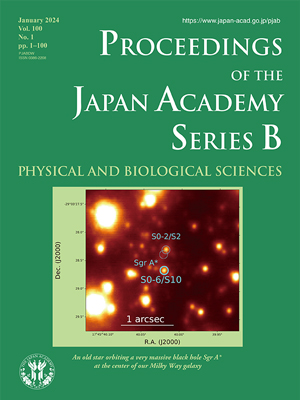About the Cover
Vol. 100 No. 1 (2024)
At the center of our Milky Way galaxy, a very massive black hole is likely to exist. A concentration of tremendous mass was found by the two groups led by Andrea Ghez and Reinhard Genzel, and they won the Nobel Prize in Physics in 2020. Recently, an image of the shadow of the black hole was taken by the Event Horizon Telescope collaboration.
Many stars, which are orbiting the massive black hole Sgr A*, are found, as seen in the cover image. They have been used as good probes to map the gravitational field around Sgr A*. However, the existence of the stars is enigmatic because of the strong gravity from Sgr A*. The black hole makes a strong tidal shear, which stretches out gas clouds near the black hole and thus prevents the gas clouds from accumulating to form stars. Hence, forming stars near the black hole is very difficult, and it is still uncertain where the stars around Sgr A* formed.
Nishiyama and collaborators observed one of the stars close to Sgr A*, S0-6 (the blue thick circle in the cover image), using the Subaru telescope, a high-resolution spectrograph IRCS (Infrared Camera and Spectrograph), and the adaptive optics system to resolve stars around Sgr A* (see the article in this issue, pp. 86–99). The region is extremely crowded with many stars; however, considering the great distance to Sgr A* from us, a chance coincidence of an intervening star is possible in principle. Nevertheless, they detected a marginal acceleration of the star along the line of sight from its velocity measurements from 2014 to 2021. Generally, stars do not show measurable acceleration within such a short period, and the detection of the acceleration means that S0-6 is subjected to strong gravity. Therefore, S0-6 is likely to be under the influence of the strong gravity of Sgr A*.
Using the near-infrared spectra, Nishiyama and collaborators also determined parameters of S0-6, such as temperature, chemical abundances, and age. They found that the temperature of S0-6 is about 3,900 K, and that mean metal abundance is about one-third of that of the solar abundance. The temperature and mean metal abundance information allows us to determine stellar ages; S0-6 is likely to be very old, more than 10 Gyr old. Additionally, the abundances of Mg, Ca, Ti, and the average of the alpha elements imply that S0-6 did not form at the center of the Milky Way galaxy. Rather, S0-6 is probably formed in a dwarf galaxy, which was orbiting our galaxy in the past and was captured by our galaxy.
Tetsuya Nagata
Emeritus Professor of Kyoto University




